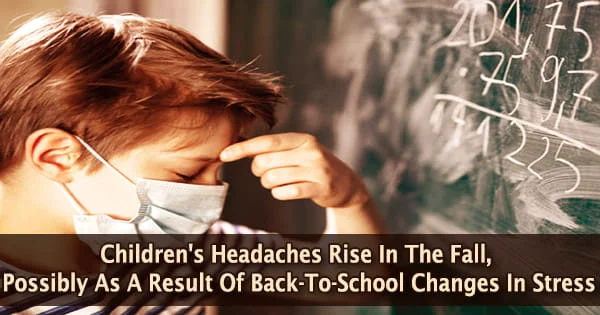Headaches in children increase in the fall, according to findings from Nationwide Children’s Hospital physicians, a tendency that could be attributed to back-to-school shifts in stress, habits, and sleep.
Although it can be difficult for parents to distinguish between a genuine headache and a child’s desire to prolong summer and postpone going back to school, there are a number of other frequent triggers, such as dehydration and excessive screen time, that can add to a child’s discomfort.
“When we saw many of our families and patients in clinic, the families would report that their child or teenager’s headaches would increase during the school year,” said Ann Pakalnis, MD, lead researcher, attending neurologist, and Director of the Comprehensive Headache Clinic at Nationwide Children’s. “So, we decided to go back and look at emergency department visits for that time period and see if there were more visits here at certain seasonal variations during the year.”
Pakalnis and fellow neurologist Geoffrey Heyer, MD, completed the study, which is based on a retrospective examination of over 1300 emergency department visits from 2010 to 2014. When monthly emergency department visits are grouped seasonally, the researchers discovered that children aged five to 18 years old have more headaches in the fall.
“We see a lot of headaches in young boys, from five to nine years of age, and in boys, they tend to get better in later adolescence,” said Dr. Pakalnis, also a professor of Clinical Pediatrics and Neurology at The Ohio State University College of Medicine. “In teenage girls, migraines oftentimes make their first presentation around the time of puberty and unfortunately tend to persist into adulthood.”
Tension headaches and migraines are the two most common types of primary headaches observed by doctors. While migraines are less common in children, the agony they suffer is significantly more acute.
We see a lot of headaches in young boys, from five to nine years of age, and in boys, they tend to get better in later adolescence. In teenage girls, migraines oftentimes make their first presentation around the time of puberty and unfortunately tend to persist into adulthood.
Dr. Pakalnis
Migraines are characterized by nausea, vomiting, and heightened sensitivity to light, sound, and smell. Tension headaches, on the other hand, are more like a tightening around the head, and youngsters can go about their daily activities despite the discomfort.
Academic pressures, scheduling changes, and an increase in extracurricular activities could all be contributing factors to the rise in fall headaches. Lack of sleep, skipping meals, dehydration, too much caffeine, lack of exercise, and excessive electronic screen time are all typical headache triggers.
These findings back up Dr. Pakalnis’ prior research by proving that lifestyle factors play a role in treating headaches and migraines and that reducing stress reduces headache and migraine frequency.
“Your brain is like your cell phone,” said Howard Jacobs, MD, a headache specialist at Nationwide Children’s. “If you don’t plug your cell phone in, it doesn’t have energy, it doesn’t work well. If you don’t plug your brain in by providing energy, it doesn’t work well and that causes headaches.”
Dr. Jacobs believes that headaches can be avoided by eating three meals a day, getting enough sleep at night without sleeping during the day, drinking plenty of water, and striving to remove the pressures from a child’s day.
Pain relievers like acetaminophen, ibuprofen, and naproxen might also assist, but if taken too frequently, they can aggravate headaches. To treat and prevent headaches, parents should consult with their child’s doctor.
“A sudden, severe headache or a change in the headache sensation from previous, what we call ‘first or worst’ headaches should be evaluated,” said Dr. Jacobs, also a clinical associate professor of Pediatrics at The Ohio State University.
“Another good rule of thumb is that if the headaches are interfering with a child’s normal routine, then it is time to get them evaluated, so therapy can be instituted to return your child’s life to normal.”





